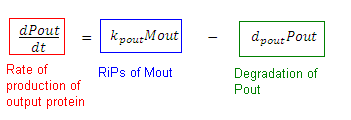Team:Imperial College London/Drylab/M1/Protein production/Analysis/Detailed
From 2009.igem.org
(→In the absence of IPTG) |
(→In the absence of IPTG) |
||
| Line 3: | Line 3: | ||
==In the absence of IPTG== | ==In the absence of IPTG== | ||
<b>Equation 1:</b> Equation describing the rate of transcription of LacI MRNA (M<sub>LacI</sub>): <br> | <b>Equation 1:</b> Equation describing the rate of transcription of LacI MRNA (M<sub>LacI</sub>): <br> | ||
| - | [[Image:II09_MOD1_M1.jpg]]<br><br> | + | [[Image:II09_MOD1_M1.jpg|centre]]<br><br> |
k<sub>mlacI</sub> is the transcription rate of M<sub>lacI</sub> (a measure of promoter strength) and d<sub>mlacI</sub> is the degradation rate. At steady state: | k<sub>mlacI</sub> is the transcription rate of M<sub>lacI</sub> (a measure of promoter strength) and d<sub>mlacI</sub> is the degradation rate. At steady state: | ||
[[Image:II09_M1_SS1.jpg|200px|centre]] | [[Image:II09_M1_SS1.jpg|200px|centre]] | ||
| Line 9: | Line 9: | ||
<b>Equation 2:</b> Equation describing the rate of translation of LacI protein (P<sub>lacI</sub>) | <b>Equation 2:</b> Equation describing the rate of translation of LacI protein (P<sub>lacI</sub>) | ||
| - | [[Image:II09_MOD1_M1_E2.jpg]]<br> | + | [[Image:II09_MOD1_M1_E2.jpg|centre]]<br> |
At steady state:<br> | At steady state:<br> | ||
[[Image:II09_M1_SS2.jpg|150px|centre]] | [[Image:II09_M1_SS2.jpg|150px|centre]] | ||
| Line 19: | Line 19: | ||
Unlike in the previous case, the output promoter is inducible. In the absence of further information, we model the effect of LacI on transcription/ POPS activity with a Hill function, which represses when amounts are above the threshold K, and activates when P<sub>lacI</sub> amounts fall below threshold. Such assumption can be revised in the light of contradicting experimental data. | Unlike in the previous case, the output promoter is inducible. In the absence of further information, we model the effect of LacI on transcription/ POPS activity with a Hill function, which represses when amounts are above the threshold K, and activates when P<sub>lacI</sub> amounts fall below threshold. Such assumption can be revised in the light of contradicting experimental data. | ||
| - | [[Image:II09_MOD1_M1_E3.jpg]] | + | [[Image:II09_MOD1_M1_E3.jpg|centre]] |
At steady state: | At steady state: | ||
| Line 26: | Line 26: | ||
<b>Equation 4:</b> Equation describing the rate of translation of protein of interest P<sub>out</sub>: | <b>Equation 4:</b> Equation describing the rate of translation of protein of interest P<sub>out</sub>: | ||
| - | [[Image:II09_MOD1_M1_E4.jpg]] | + | [[Image:II09_MOD1_M1_E4.jpg|centre]] |
At steady state: | At steady state: | ||
Revision as of 16:10, 14 September 2009

In the absence of IPTG
Equation 1: Equation describing the rate of transcription of LacI MRNA (MLacI):
kmlacI is the transcription rate of MlacI (a measure of promoter strength) and dmlacI is the degradation rate. At steady state:
Equation 2: Equation describing the rate of translation of LacI protein (PlacI)
At steady state:
where klacI is the translation rate of lacI protein and dplacI is the degradation rate of PlacI.Equations 3 and 4 describe the transcription and translation of the protein of interest Pout.
Equation 3: Transcription of Pout
Unlike in the previous case, the output promoter is inducible. In the absence of further information, we model the effect of LacI on transcription/ POPS activity with a Hill function, which represses when amounts are above the threshold K, and activates when PlacI amounts fall below threshold. Such assumption can be revised in the light of contradicting experimental data.
At steady state:
Equation 4: Equation describing the rate of translation of protein of interest Pout:
At steady state:
When IPTG is introduced
Parameters and values
 "
"









